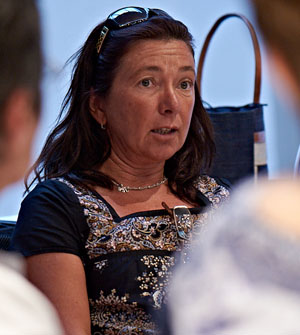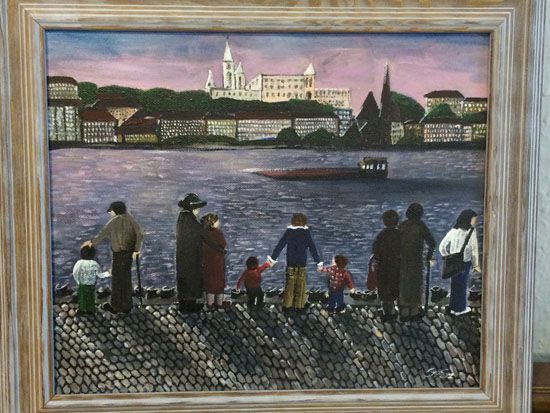
Szilvia Szunyogh
Szilvia Szunyogh was so moved by the recent Teaching with Testimony in the 21st Century program in Hungary that she created a heartfelt painting about the experience.
Szunyogh teaches painting for first-sixth graders, geography for middle-school students, and media for 8th graders at Herman Ottó Elementary and Middle School and Art Institute in Miskolc, Hungary. She first worked with the Visual History Archive while teaching high school art, when her students participated in USC Shoah Foundation’s contest in which students in Eastern Europe were asked to create drawings based on clips of Holocaust survivor testimony. The experience inspired her to participate in the 2014 Teaching with Testimony in the 21st Century program this summer.
“Watching the testimony not only resulted in great artwork but also initiated a meaningful conversation. This was when I realized that personal stories have greater impact on students than any literature, film or history teaching material,” Szunyogh said. “This is why I wanted to learn more about the possible uses of testimonies in education.”
As part of this year’s Teaching with Testimony program in Budapest, in addition to learning about the Visual History Archive and how to incorporate it into their teaching, the participants went on an IWalk led by Andrea Szonyi, USC Shoah Foundation international training consultant in Hungary. They visited historic sites in Budapest, including the Shoes on the Danube memorial, where they used tablet devices to watch clips of testimony in which survivors recall their experiences at this historic site. Szunyogh said the IWalk was the most memorable part of the program for her.
“I thought I knew a lot about the Holocaust, but after I watched the many, many testimonies during the program I had to realize I know nearly nothing,” she said.
After the training was over, Szunyogh went on vacation, but she couldn’t stop thinking about the Teaching with Testimony program and all the testimonies she had watched. To help herself make sense of what she had learned and get closure on the experience, she painted a picture of the Shoes on the Danube memorial.

The painting was also a way for her to show her appreciation for everything she learned at the training.
“I wanted to somehow give something in exchange for all the kindness and help we received from the program leaders,” she said.
Szunyogh hopes to include testimonies in her primary school painting classes for a lesson on holidays and celebrations, and the role of art in elaborating about trauma. She will also use testimony in her eighth grade media class’s lesson on Schindler’s List.
She said teachers should use testimony from the Visual History Archive in their classrooms because the honesty of the survivors, as they share the most horrifying parts of the lives, is more moving and authentic than any textbook.
“The personal story of the individual evokes emotions which is very important when we deal with this topic,” Szunyogh said. “Empathy is indispensable.”